In the course of reducing my footprint for environmental purposes, I found that low-footprint living was also a great way to reduce my financial overhead. This was great for me, since the work I am passionate about and feel committed to doing (eco activism; eco education) has not generally been a major source of income for me.
At times, my annual income has been as little as $7,000, before taxes. Most of the time it’s been around $13,000-15,000.
So how do I manage? Here are some of the main ways:
– Always have roommates or housemates. With roommates/housemates to split costs, my expense to keep a roof over my head has never been over $400 a month for my whole adult life (with the exception of a period of a few years when I was living more of a “typical middle-class” lifestyle). And at times, that expense has been as low as $250 or $300. (Right now it’s about $300.)
– Don’t own a car. Living in a walkable or at least bikable area is a deal-breaker for me. Always get jobs near where I live, or work at home. By cutting out the car I eliminate enormous hassle, and an expense that for most people typically ends up being several hundred dollars a month one way or another (be it from a car payment, repairs, or both). I spend maybe a hundred dollars a year on Uber rides or putting gas in a car borrowed from a friend for a trip I can’t do by foot, bicycle, or bus.
– Don’t use air conditioning. The human body is actually very physiologically adapted to heat, more so than cold. Since I live in Florida, I can get away without using heat too. Some people I know have heating/AC bills that are 100, 200, or even several hundred dollars a month.
– No cable internet bill. I have a phone with unlimited data for $50 a month. If I really wanted some TV or movies, I could sign up with Hulu or Netflix for a few bucks a month.
– Clothing: I enjoy fashion, but a little goes a long way, and I get lots of good stuff for cheap at the thrift shop. As it happens, I also like to sew, knit, etc., so I buy old clothing items and “edit” them to my unique tastes.
These are the main big overhead costs of USA-merican life, in my experience. By cutting these, I greatly reduce how much money I need to earn to live well, and get to do the work I feel truly passionate about and committed to doing.
Of course, even if you have a high income, you can benefit greatly by minimizing your overhead. Think what you might do with all the money you free up. Start a side business or charity? Become a supporter of the arts in your community? Buy a piece of vacant land in your city and create a public food forest? The possibilities are endless.
Now, many people have large ongoing expenses such as medical bills or student-loan debt. My heart goes out to you. And, living a low-footprint life in the way described above can help you not only get free of debt faster, but also not be so squeezed in the meantime.
I encourage you to pursue the work you feel passionate about, whatever it is. Do what it takes to minimize your overhead so you have some breathing room. Not only is it about getting to have your freedom; it’s also about making your highest contribution to the planet.
On the subject of increasing one’s prosperity by reducing one’s footprint, today I discovered a book called Go Green, Live Rich, by financial writer David Bach. I bought a copy today and have just started reading. Here is a review of the book on TreeHugger.
